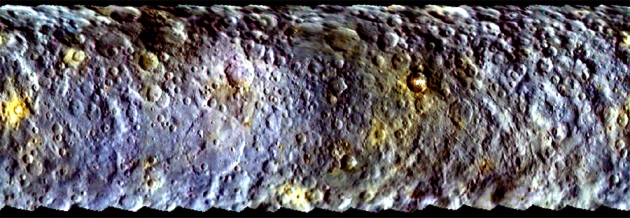Mystery of Ceres’ bright spots grows
Data from NASA mission suggest varied origins for tantalizing gleams on dwarf planet’s surface.
NASA/JPL-Caltech/UCLA/MPS/DLR/IDA
The surface of the dwarf planet Ceres (shown here) has fewer large craters than researchers expected.
Not all of the puzzling bright spots on the dwarf planet Ceres are alike. The closest-yet images of the gleams, taken from 45,000 kilometres away, show that at least two of the spots look different from one another when seen in infrared wavelengths.
NASA’s Hubble Space Telescope spied many of the bright spots years ago, but the observations from NASA’s Dawn spacecraft — which began looping around Ceres on 6 March — are the first taken at close range. The images were released on 13 April in Vienna at a meeting of the European Geosciences Union.
Scientists say that the bright spots might be related to ice exposed at the bottom of impact craters or some type of active geological features. The areas glimmer tantalizingly in a new full-colour map of Ceres that was obtained in February, but not released until the conference. The map uses false colours to tease out subtle differences on the otherwise dark surface of Ceres.
“This is the first idea of what the surface looks like,” said Martin Hoffmann, a Dawn scientist from the Max Planck Institute for Solar System Research in Göttingen, Germany.
The Dawn spacecraft’s view of the bright regions is sharpening as it gets closer to Ceres. The new infrared images reveal differences between spot 1, near Ceres’s equator, and a pair of bright spots collectively known as spot 5. Some scientists have speculated that the latter could be an icy plume.

